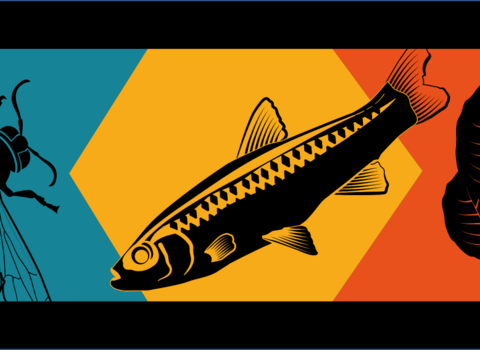What are invasive non-native species?
Invasive non-native species have been introduced by humans, intentionally or unintentionally, beyond their natural range. Their spread threatens native biological diversity and can cause damage to the environment, the economy, our health and the way we live.
Invasive non-native species (INNS) are also referred to as Invasive Alien Species (IAS). Here we refer to them as invasive species.
Wales Resilient Ecological Network
The Wales Resilient Ecological Network (WaREN) will establish a framework for tackling invasive species across Wales. We will develop linkages between stakeholders who are taking action on invasive species, with existing projects such as the Our River Wellbeing project on the river Dee and Local Action Groups in Wales. Local Action Groups focus on reducing the risks and impacts of invasive species in their local area, for example through direct management. WaREN will also increase public engagement to raise awareness of invasive species through effective science communication and sharing best practice.
WaREN is a partnership project being delivered by North Wales Wildlife Trust, find a list of our project partners below.
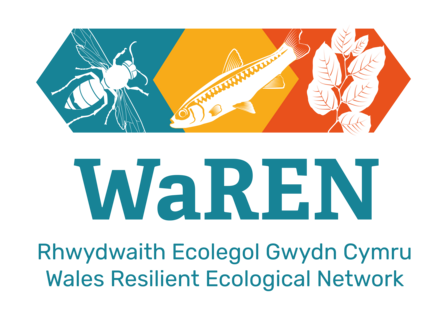
© WaREN
Meet the WaREN team
Gareth Holland-Jones - Project Manager
Gareth is responsible for ensuring that this ambitious project is delivered and an invasive species strategy is developed for Wales. Gareth is passionate about bees, particularly bumblebees. He has studied how Agricultural Land Classifications affect bumblebees across the Vale of Clwyd (North Wales). He investigated how both bees and bumblebees are attracted to the flowers of invasive plant species and the potential effects on native floral species.
Email: Gareth.Holland-Jones@NorthWalesWildlifeTrust.org.uk
Telephone: 07508740561
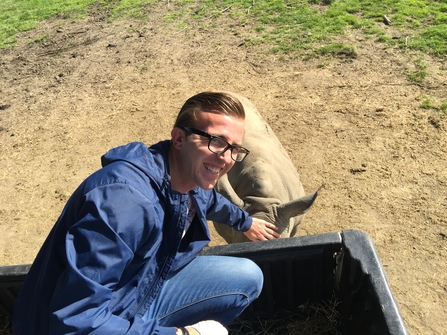
Charlie Richards - Project Officer (North)
Charlie is the WaREN Project Officer for North Wales based at North Wales Wildlife Trust. He engages the public, local action groups and stakeholders to educate and raise awareness of invasive species. Charlie has a specialty in biosecurity and has installed an automatic washdown station on the river dee and several boot brushes on NWWT reserves to prevent the spread of invasive species across wales.
Email: Charlie.Richards@NorthWalesWildlifeTrust.org.uk
Telephone: 07946089180
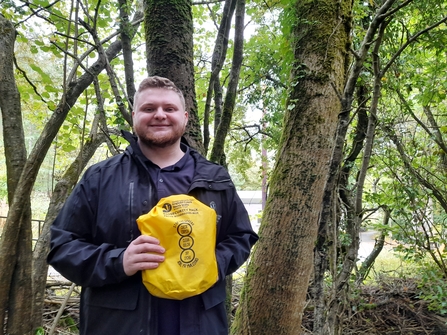
Project Officer (Mid)
Mid Wales Project Officer Coming soon!! Please direct enquiries to the North Wales Project Officer (above).
Project Officer (South)
South Wales Project Officer coming soon!! Please direct enquiries to the North Wales Project Officer (above).
Why is this important?
Invasive species are one of the main threats to biodiversity globally. They have negative impacts on our environment. For example:
- Competition for resources such as light and water
- Predation on native species
- Carrying new diseases
- Hybridisation - where invasive species breed with closely related native species
Invasive species can also impact on human health and the economy. For example, they were estimated to cost Wales at least £125 million in 2010, a cost which is likely to be increasing. There is information here on current Alert Species and how to report them.
Examples of invasive species....
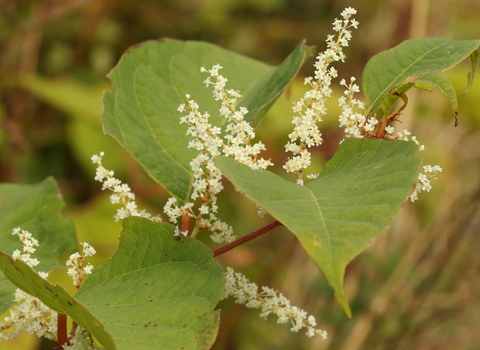
Japanese knotweed © Vaughn Matthews
Japanese knotweed
Japanese knotweed (Reynoutria japonica or Fallopia japonica) was first recorded in the wild in GB in Maesteg, South Wales, in 1886. Knotweed doesn’t spread through seeds but through underground creeping rhizomes. A tiny fragment of rhizome can grow into a new plant! Japanese knotweed can grow through hard materials and cause structural damage to properties. The best way to treat Japanese knotweed is through chemical control, check out this guidance from Welsh Government for more information.
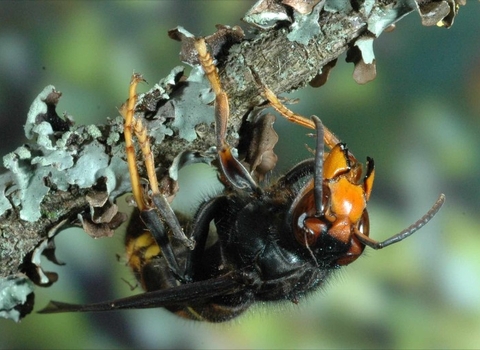
Asian hornet worker © National Bee Unit
Asian hornet
The Asian hornet (Vespa velutina) is not yet established in the UK but has been recorded in GB since September 2016. Although they are smaller than our native hornet they can grow up to 3cm in length and are highly aggressive predators which will hunt our native honey bees. Asian hornets are an Alert Species, if you spot one you need to report it, find out how to report your sighting and more info on Asian hornets here.
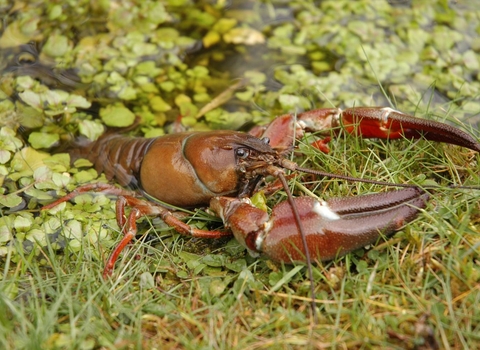
Invasive non-native species American signal crayfish ©Trevor Renals
Signal crayfish
Signal crayfish (Pacifastacus leniusculus) were first introduced in 1976, they then rapidly spread throughout the UK in the 70s and 80s. Once established signal crayfish are very difficult to remove, they predate on native aquatic species and burrow into riverbanks destabilising them. Signal crayfish also carry the crayfish plague which is deadly to our native white-clawed crayfish populations.
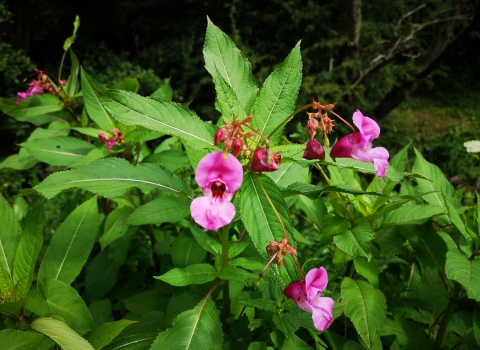
© NWWT
Himalayan balsam
First recorded in 1839, Himalayan balsam (Impatiens glandulifera) has now spread throughout the UK and is often found along river banks where it takes over and out-competes native flowers. Himalayan balsam has exploding seed pods, which can fling each plant 800 seeds up to 7m away from the plant. You can easily remove balsam by pulling it out by the roots, check out this blog for more information.
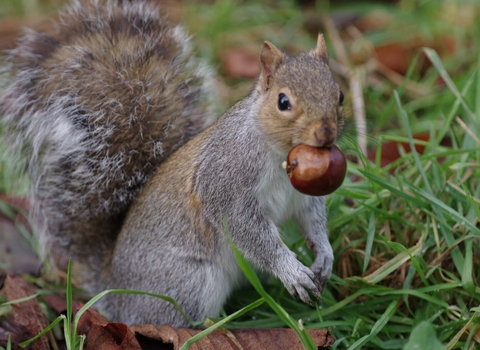
© Gillian Day
Grey squirrel
The grey squirrel (Sciurus carolinensis) is native to North America and was first recorded in GB in 1828. Their import was declared illegal in 1938, but by this time they were already well established and were rapidly spreading. Grey squirrels pose a major threat to our native red squirrel populations. They are able to outcompete them for food and habitat, and also carry squirrel pox, a disease which is deadly to our native red squirrels. Be sure to report your squirrel sighting (grey and red) using the LERC Wales App.
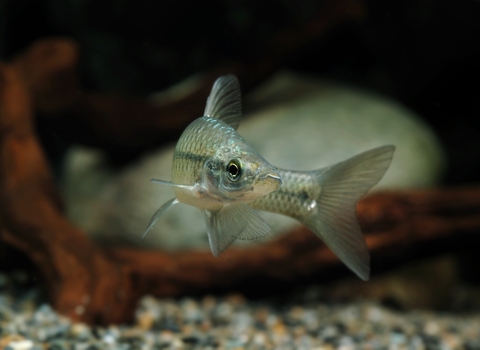
Topmouth gudgeon
First recorded in the wild in 1990, topmouth gudgeon (Pseudorasbora parva) is an ornamental species that was brought to GB through the pet trade. Although they are small, up to 11cm, they are able to quickly colonise areas and have major impacts on native species through competition, predation and by carry diseases and parasites. Topmouth gudgeon is an Alert Species, if you spot one please report the sighting to the UK Centre of Ecology and Hydrology.
How can you help?
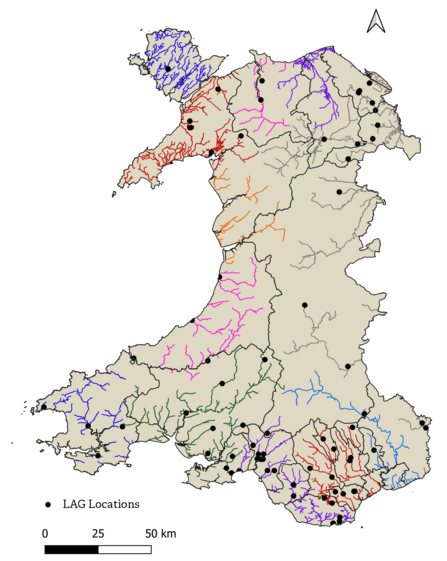
Local Action Group (LAG) Locations (2022), main rivers sourced from NRW.
If you are involved in a Local Action Group (LAG) or want to volunteer to tackle invasive species anywhere in Wales, please get in touch with one of the Project Officers. We are collating a list of Local Action Groups to improve collaboration and to gather experiences across Wales. You can also help by identifying and recording invasive species - see below!
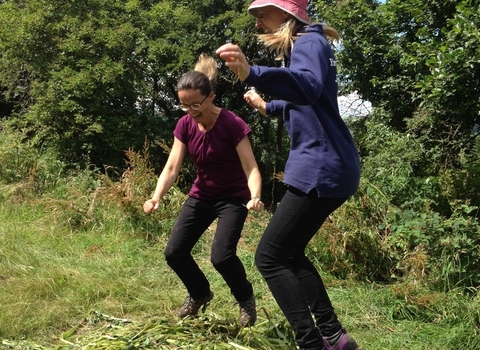
Volunteers 'balsam bouncing' © Lesley James
Help tackle invasive species
Local Action Groups
Invasive non-native species American signal crayfish ©Trevor Renals
Want to identify invasive species?
Download our pocket ID guide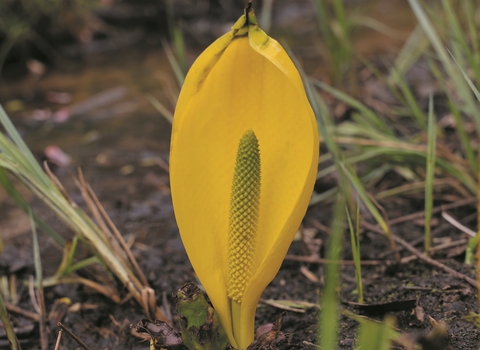
Report sightings of invasive species
Report invasive species using INNS MapperSupporting volunteer action in Wales
Have you ever thought about tackling invasive species in Wales?
Well look no further, why not try volunteering with your local Wildlife Trust, or check out our Invasive Species Toolkit below to find out more about Local Action Groups and how you can help tackle invasive species in Wales!
WaREN Invasive Species Toolkit
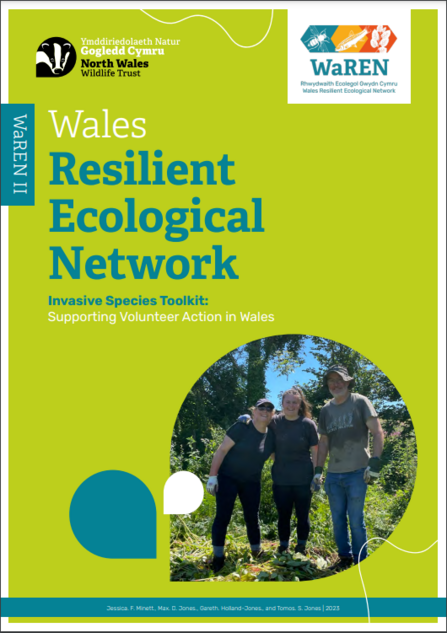
© WaREN
The WaREN Invasive Species Toolkit aims to support volunteer action and help you tackle invasive species in Wales. This toolkit is a ‘one-stop-shop’ and should include all of the resources you need, including information on: invasive species in Wales, best practice management, project planning, biosecurity and awareness raising.
There are lots of ways you can help tackle the threats posed by invasive species. This toolkit breaks down this information to help you protect our environment. You can download a pdf of the toolkit or view a summary of each section below.
ID and Reporting Invasive Species
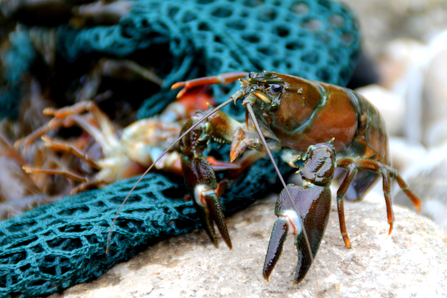
American signal crayfish (Pacifastacus leniusculus)
Welsh Priority Species
The Invasive Priority Species for Action in Wales list can be split into three action categories:
- Prevention
- Management
- Long-term Management
They are chosen based on horizon scanning, risk analysis, and consultation. Species are included on the list as they are a GB priority species, an Invasive Alien Species of Union Concern, or are a species considered a national priority for Wales.
Here you can find ID guides and information on all current (2018) Invasive Priority Species for Action in Wales.
Species Alerts
Species Alerts are a key part of the early warning and rapid response to a new invasion. They are often used to raise awareness of particular species, inform the public on the action that may be required, and encourage reporting of species sightings. Check out the current Alert Species and where to report sightings on the GB NNSS website.
Reporting
Recording sightings of invasive species is essential in allowing us to coordinate management and strategically tackle invasive species. In Wales there are four Local Environmental Record Centres (LERCs) where you can report invasive species sightings. You can also use a variety of apps and online tools, such as , such as iRecord or the LERC Wales app.
A partnership project is currently developing a tool called INNS Mapper for recording invasive species across GB. Importantly this will enable you to record your management efforts. Find out more here.
Management
© Jess Minett
Before managing an invasive species, it's really important to think about the follow three points:
- Know your species - what are the characteristics, such as life cycle and dispersal methods of your chosen invasive specices?
- Know your site - what are the characteristics of the habitat or environment – resource availability (e.g., light, water, etc.), level of disturbance, and sources of spread into the area?
- Know your neighbour - who lives near your site? Who might be interested in what you’re doing? What stakeholders in your community could support your work?
Your management actions can all be affected and altered by the species, site, and your neighbours.
Good practice management
Here we have linked to good practice management guides for all of the Invasive Priority Species for Action in Wales. You can find good practice management information on species not on the Invasive Priority Species for Action in Wales list from organisations such as: GB NNSS, CABI and Invasive Species Northern Ireland.
Licencing
You may require a licence to carry out certain activities and manage some invasive species. Find out more about what licences may be required and how to obtain them in Management section of the toolkit.
Project planning
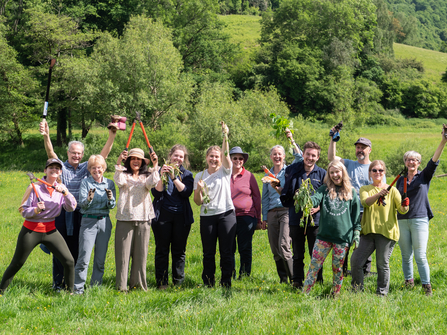
© Wye Valley AONB
Local Action Groups
Local Action Groups (LAGs) are volunteer-run community groups set up to tackle local issues, such as, invasive species. LAGs play a crucial role, often carrying out work on the ground and getting directly involved in invasive species management in their area. Without LAGs a collective effort to tackle invasive species would not be possible. You can:
- Find a LAG near you on the GB Non-Native Species Secretariat or
- Follow our simple guide below to setting-up a LAG in your area.
Setting up a LAG
Begin by considering your group’s purpose (the reason you want to set up a LAG), aims (broad targets that you want to achieve) and objectives (how your LAG will achieve its aims). Make your objectives:
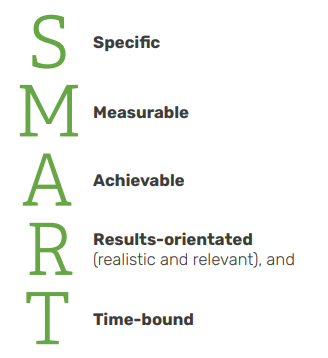
© WaREN Invasive Species Toolkit 2023
To ensure your objectives are achievable, we recommend you follow the SMART methodology.
Objectives can be further split into tasks; these tasks can be used as milestones to monitor progress.
Next you’ll need a name! Have you also thought about what members your group requires? At first you may not need many members, but as your group grows you may wish to consider having a member responsible for Health and Safety officer or database management. This allows people with different interests to join in.
Now it’s time to promote your group, find volunteers and keep them engaged! You can do this by:

© WaREN-NWWT
- Creating a Facebook group
- Post flyers/posters around community
- Link to other environmental issues
- Don’t forget to thank people for their work!
You can find more information and download helpful templates, e.g. strategic action plan, governing documents and risk assessments from the project planning section of our toolkit. Or contact one of our project officers for advice.
Now it's time to get tackling invasive species!
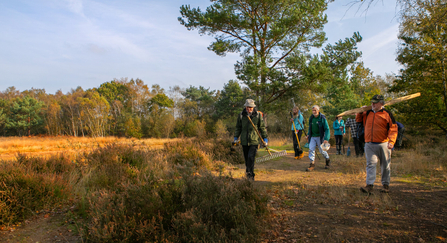
Volunteers in Surrey - Jon Hawkins - Surrey Hills Photography
Monitoring and managing invasive species
To effectively and collectively manage invasive species in Wales we need to:
- Know where invasive species are, and
- Know whether they are being or have have been tackled.
Surveying
Surveying is straight forward and used to determine what species are present. Surveys are often the first step towards invasive species control! Start by trying to identify the upper-most source of the invasive species distribution. Control actions can then be implemented working downstream.
Management
You must choose the most appropriate management method to successfully and effectively control invasive species. Management methods can typically be split into four categories:
- Mechanical
- Chemical
- Biological/natural
- Environmental
Check out or invasive species best practice management section of the Toolkit for species specific advice!
Don't forget to report your survey data, invasive species sightings and management actions to INNS Mapper.
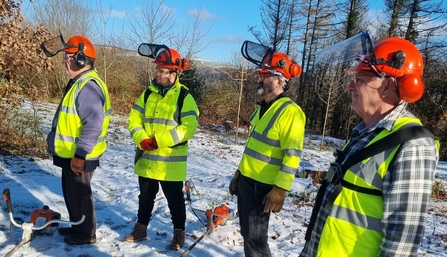
© Andy Morris
Funding
Check out the project planning section of the Toolkit for more information on what funding opportunities are available or get in touch with one of our project officers for more advice.
Biosecurity
© NWWT
What is biosecurity?
Biosecurity describes any steps taken to reduce the introduction and spread of invasive species. We can all easily and accidently introduce and transport invasive species through leisure activities e.g. gardening, water sports and hiking. But by implementing simple biosecurity practices such as cleaning equipment and clothing, e.g. cleaning footwear after a walk, we can limit their spread and protect our wildlife! You can find out more about biosecurity here or check out our biosecurity best practices below.

© WaREN - NWWT
Biosecurity kit
Biosecurity is simple! Be sure to clean your kit between sites and make sure to pay attention to any areas that are damp or hard to access.
You can easily put together your own personal biosecurity kit, all you need is:
© WaREN - NWWT
- Plastic storage box/bag
- Hard brush
- Hoof pick or boot tread scraper
- Supply of clean water
Biosecurity Risk Assessments
Before you run any events or activities, it is vital to consider biosecurity and make sure you are not accidently spreading invasive species. You need to assess your activity and sites risk level in order to implement suitable biosecurity best practise measures. To find out more about how to assess you risk level download the biosecurity section of the Toolkit.
Biosecurity Best Practice
We have developed biosecurity best practice advice for low, medium and high-risk activities/sites.
At low risk sites you need to:
- Wear footwear and clothing that can be easily cleaned
- Clean your footwear and ensure it is free of any soil or organic debris after use
- Only take the required equipment onto site
- Ensure you have your personal biosecurity kit
- Only access areas of the site that are required for the activity
To find out more about medium and high-risk biosecurity best practice procedures download the biosecurity section of the Toolkit.
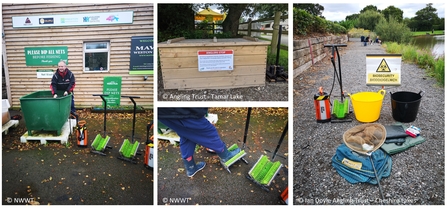
National campaigns
Check out these national campaigns to find out more about biosecurity.
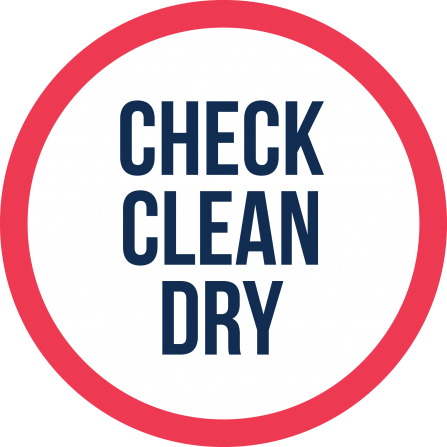
Check Clean Dry provides simple advice for recreational water users. However, this advice should be applied to all aspects of biosecurity regardless of whether you have been in contact with the water.

Be Plant Wise ©GBNNSS
Be Plant Wise was set up to raises awareness of the impacts of invasive plants and encourages people to properly disposal of plant material.
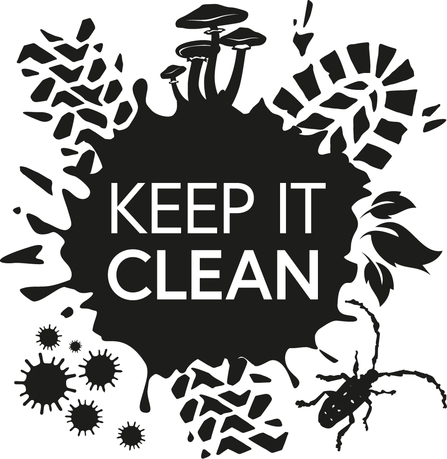
© Forestry Commission
Keep it clean provides advice for activities and focuses on keeping our green spaces free of plant diseases
Find out more about biosecurity visiting our biosecurity webpage, or by checking out the biosecurity section of our Toolkit.
Raising awareness of invasive species
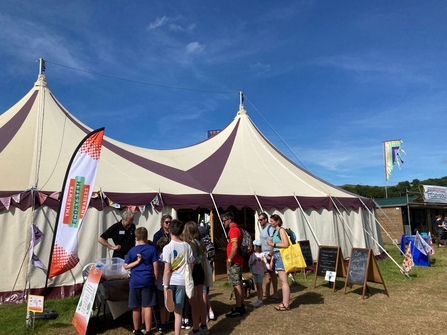
© Tomos Jones - NWWT
The impacts of invasive species will continue to grow unless they are tackled through a sustainable and collaborative approach. That’s why we need your support! Please help us raise awareness of invasive species and their impacts in Wales to improve public understanding.
Campaigning and key messages
There are a few national campaigns in Wales and GB that aim to raise awareness of invasive species and promote biosecurity. For example, Invasive Species Week, which is held annually in Spring.
Ymledwyr Ecosystem Invaders
Ecosystem Invaders is a campaign run in Wales by WaREN. The campaign aimed to raise awareness of invasive species and their impacts in Wales to improve public understanding. Find out more about Ecosystem Invaders here, you can also access some of our campaign materials in the Toolkit!
INNS Mapper
Introduction to INNS Mapper (https://www.youtube.com/watch?v=Uyqy3PqGYrA)
An introduction to INNS Mapper.
INNS Mapper is an app and website for the reporting of sightings, surveys and management of INNS (Invasive Non-Native Species) in England, Wales and Scotland.
INNS Mapper is free to use and aims to provide an effective resource to support INNS programmes and coordinate efforts.
The INNS Mapper app and website are available in Welsh and data reported to INNS Mapper is open-access and publicly available for anyone to use.
Please find the following supporting videos for using INNS Mapper:
WaREN Newsletters
To improve dialogue between WaREN members, we are formalising our contact with regular newsletters. We hope this will function as a platform to share successes, best practise and also challenges! If you want include content in our newsletter please contact us.
- September 2022 (https://www.northwaleswildlifetrust.org.uk/sites/default/files/2022-09/WaREN_September2022Newsletter_English_0.pdf)
- November 2022 (https://www.northwaleswildlifetrust.org.uk/sites/default/files/2022-11/WaREN_November_FullNewsletter_English.pdf)
- January 2023 (https://www.northwaleswildlifetrust.org.uk/sites/default/files/2023-01/WaREN_January_FullNewsletter_English_2.pdf)
- March 2023 (https://www.northwaleswildlifetrust.org.uk/sites/default/files/2023-03/WaREN_March_FullNewsletter_English_0.pdf)
- September 2023 (https://www.northwaleswildlifetrust.org.uk/sites/default/files/2023-09/WaREN_September_FullNewsletter_English.pdf)
Our partners
WaREN is a partnership project being delivered by North Wales Wildlife Trust and Wildlife Trust of South and West Wales. Our Project Board partners are listed below.

© WCVA

